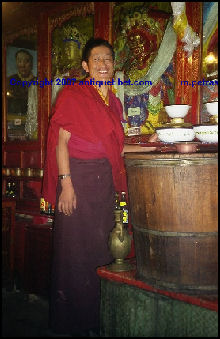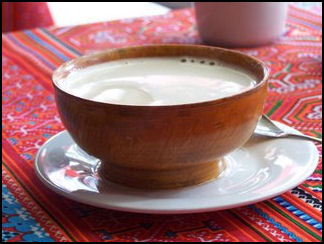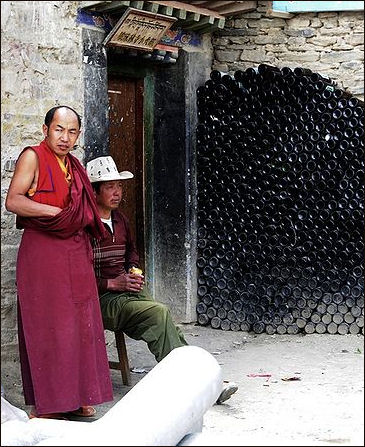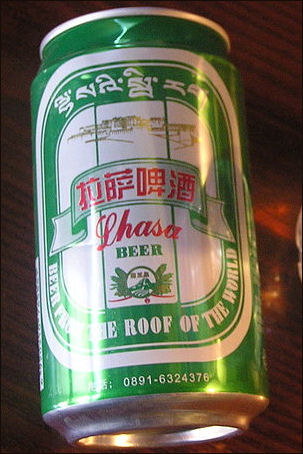TIBETAN DRINKS AND DRUGS

Making chang
Famous Tibetan beverages includes the chang (traditional highland barley beer or wine), buttered tea, sweet tea, milk tea, fresh yak milk and sour milk. The Lhasa beer made from pure underground water has taken on the brand “Medicine King Hill”. Across Tibet, many places produce mineral waters containing different trace elements. The highland barley wine is fermented directly from highland barley and tastes sweet and sour with low amount of alcohol. Similar with the rice wine in Central China, the Tibetan highland barley wine tastes quite different from the highland barley wine made in Qinghai and Gansu. [Source: Chloe Xin, Tibetravel.org]
The alcoholic drink favored by some Tibetans is "qingke jiu", a potent barley beer, wine or spirit. Qingke jiu is an "acquired" taste that many travelers can't swallow without a grimace. An alternative is Tibetan barley beer, known as chang. Quality varies but mostly you can expect a mild beer that is slightly sweet served out of a can. "Rakshi" is a local moonshine made from the root of a purple flower. Many Tibetans like to relax by drinking beer. Alcoholism is a serious problem in some Tibetan areas. Some Tibetans don’t drink for religious reasons.
Chang is simple to make. First, barley is washed and cooked. Distiller's yeast is added into it after it is cooled, and the brew is placed into a pottery jar, which is then sealed and covered with a Tibetan blanket. That increases the temperature to make the barley ferment. The jar is unsealed several days later; add an appropriate amount of pure water is added before it is sealed for a day or two more. See Chang Below.[Source: chinaculture.org, Chinadaily.com.cn, Ministry of Culture, P.R.China]
Wild marijuana grows in a lot places in the Himalayas, China and Central Asia. In some places it is boiled and fed to pigs. Some Tibetans smoke tobacco in cigarettes hand rolled with newspaper. Others like to snort snuff — powdered tobacco.
See Separate Articles: TIBETAN FOOD: TSAMPA, YAK MEAT AND CRISPY OIL factsanddetails.com; TIBETAN ETIQUETTE AND CUSTOMS factsanddetails.com
RECOMMENDED BOOKS: “Have a Cup of Tibetan Tea” by David B Woodward Amazon.com; “Yak Butter & Black Tea: A Journey into Tibet” by Wade Brackenbury Amazon.com; “Tea Horse Road: China's Ancient Trade Road to Tibet” by Selena Ahmed and Michael Freeman Amazon.com; “The Ancient Tea Horse Road”by Jeff Fuchs Amazon.com; “The Ancient Tea Horse Road: Travels With the Last of the Himalayan Muleteers” by Jeff Fuchs Amazon.com “The Teacup and the Skullcup: Where Zen and Tantra Meet” by Chogyam Trungpa , Judith L. Lief, et al. Amazon.com; “Taste Tibet: Family Recipes from the Himalayas” by Julie Kleeman and Yeshi Jampa Amazon.com; “Food in Tibetan Life” by Rinjing Dorje Amazon.com; Tibetan Life and Customs: “A Hundred Customs and Traditions of Tibetan People” by Sagong Wangdu and Tenzin Tsepak Amazon.com; Magic and Mystery in Tibet: Discovering the Spiritual Beliefs, Traditions and Customs of the Tibetan Buddhist Lamas” by Alexandra David-Neel and A. D'Arsonval (1931) Amazon.com;“Tibetan Life And Culture” by Eleanor Olson Amazon.com; “Tibetan Buddhist Life” by Don Farber and The Tibet Fund Amazon.com; “Women in Tibet: Past and Present” by Janet Gyatso and Hanna Havnevik Amazon.com; “The Unique Customs and Taboos in Tibet and Their Meanings” by Kokshin Tan Amazon.com; “Customs and Superstitions of Tibetans: by Marion H. Duncan (1964) Amazon.com;
Tea and Life in Tibet
Tibetans often drink tea three times a day. In the morning, they drink tea containing fried flour, milk dregs, and butter to put something in their stomachs and get themselves going. After lunch, they often drink several bowls of tea in order to help their digestion and fight fatigue. After supper, the whole family usually sits around the table, socializing while drinking tea. [Source: chinaculture.org, Chinadaily.com.cn, Ministry of Culture, P.R.China]
In Tibet, tea serves many purposes. It is a symbol of hospitality, a sacred offering, and a meal in itself. People drink the tea alongside flat cakes of ground corn, barley, and buckwheat and mix it with flour to make tsamba. The tea is offered to guests in villages, monasteries, or private homes as a sign of hospitality, and must be consumed before conversation can begin. Tibetans love tea so much that the Chinese and the British thought they could subdue the Tibetans by manipulating their tea supply. Many Tibetans considered Chinese and British tea to be horrid stuff.
Tibetans pay close attention to way tea is sipped. Bowls that contain should not flawed in any way and the tea bowl should be held with both hands. When refilling the bowl, the palm of the left hand should face the sky, and no tea should spill out of the bowl. When one has guests, he or she will entertain them with tea. Parents and elders are often toasted with tea. When older people themselves sit together, they sip tea, gossip, and often recite the Six-Syllable Prayer. When going to visit friends, one's gifts should include tea. If lamas are invited to recite sutras in the home, others should not touch the utensils that the lamas use. When a couple becomes engaged, tea is indispensable because it represents everlasting ties to Tibetans. When the bride reaches her husband's home for the first time, she should go directly to the kitchen, where she will make tea for her parents-in-law.
Tibetan Tea
Tibetans drink tea several ways: the most well-known is the buttered tea. This is a unique way to drink tea in highland and cold areas. The tea is made with butter and salt (or milk) in a special tea barrel. While stirring it some Tibetans add egg or walnuts. Another kind is the sweet tea stewed with high-quality black tea, fresh milk or milk powder and white sugar. Tibetans enjoy other types of tea as well, such as green tea, milk tea and boiled black tea. [Source: chinaculture.org]
In Tibet, brick tea is crushed and soaked in water overnight, then mixed with rock salt, goat‘s milk and yak butter. Tsampa, a soup-like food, is made with barley flour mixed with tea. In Tibet, tea—sweet or buttered—is like coffee for a Westerner: refresher, leisure time beverage to drink with friends, a drink to wake up and start the day. In Tibet no morning can pass without drinking some tea, usually the sweet tea, and no meal is complete without some tea, usually Tibetan buttered tea.
Whether it be sweet tea or buttered tea, tea is often served from small or large thermos as both kinds of tea are best when served hot. Some say the local habit of drinking is tied to local eating habits. Tibetans eat lots of meat. Hot buttered tea not only helps to keep the body warm, Tibetans believe, it also helps to promote the digestion of the meat often consumed three time a day, 365 days a year. A local saying goes that others cannot do without salt whereas the Tibetans cannot do without either salt or tea.
Tibetans mix tea with cold water in a teapot, before heating over a small fire. When the water turns brown, the good tea is ready. Many Tibetans add salt in their tea. In some areas, Tibetans put fruit, ginger, and peppers in tea. Such tea is believed to cure headaches and colds. Tea with brown sugar is believed to be good for pregnant women and women who have just given birth. Tibetans in the Amdo area love broad-leafed tea and tea bricks. A tea brick, which is rectangular in shape, usually weighs two kilograms. Such a tea bricks can withstand journeys and was used when tea was traded over long distances to reach Tibet.
Sweet milk tea is widely consumed in Tibet. Hot boiling black tea is filtered and poured into a churn, and then fresh milk and sugar are added. Vigorous churning produces a light reddish white drink. Many teashops specialize in sweet milk tea.
Tibetan Butter Tea

Yak butter tea
Buttered tea is the favorite drink of Tibetan people. It usually consumed while eating Tsampa. Often it is made with boiled brick tea and ghee. Ghee, which looks like butter, is a kind of dairy product made of fat obtained from cow milk or sheep milk. Tibetan people like the ghee made of yak milk. When they make buttered tea, they mix boiled brick tea and ghee in a special can, add some salt, pour the mixed liquid into a pottery or metal teapot and finally heat it up (but do not boil it). Different people have different tastes for the buttered tea.
Some people like salty flavor, others prefer to light flavor. People who do manual labor, especially men, like the strong-tasting, cream-like buttered tea. Old people, children and women, it is said, favor light-flavored tea. People usually heat up the buttered tea because cold buttered tea, it is said, is not easy to digest and may harm the stomach.
Buttered tea is called "Jiasuima" in Tibetan and pencha in Chinese. It is regarded as a nutritious drink well suited for high and cold region regions. Tibetans drink as much as 40 cups of tea a day. It is filling and the caffeine in it give those who drink it a slight jolt. Tibetan and Chinese say it helps one resist coldness, it promotes body fluids, quenches thirst, and get rid of fatigue. Tibetan people drink several cups of buttered tea in the morning and then go to work. The following is a quick Tibetan butter tea recipe: Boil one tablespoon of loose black tea; leave for 10 minutes. Strain. Add 1/4 cup heavy cream, one tablespoon butter, and salt. Tibetans drink their tea very salty. Indian milk tea is sweet.
Tibetans often offer pencha as a hospitality gesture and insist that the cup be finished and a refill offered. Foreigners often wretch and nearly throw up the first time they try Tibetan tea with yak butter. But after a while they get used it and after drinking it many times over a long trip some even like it.
Making Tibetan Butter Tea
Pencha (Tibetan tea) is brewed with an equal measure of salt and yak butter, giving it a consistency like soup. The drink is made by scrapping tea from a brick of black tea and boiling the tea leaves with rock salt or soda and yak butter and milk while the mixture is churned in a wooden tube.
To make Tibetan butter tea: boil brick tea in water for a long time into red thick juice, pour the juice into a specially made round wood pail which is 90 to 120 centimeters long with a diameter of 10 centimeters, and add an appropriate amount of butter or ghee (oil extracted from milk of cow or sheep) and salt. Tibetan butter tea is often blended in a slim wooden cylinder. After the mixture is put in the cylinder, a piston is used to push and pull inside the cylinder. With the passing of the mixture through the slit between the piston and the cylinder, the mixture of butter, salt and tea is forcefully and thoroughly blended. Then it is poured into a pot or boiler, is put on slow fire and is ready to be poured out for drinking. [Source: Liu Jun, Museum of Nationalities, Central University for Nationalities, kepu.net.cn ~]
Cathy Ang wrote: “Tibetans have a special churning cylinder for making their butter-tea. First they boil the tea (almost always brick tea) for ten to fifteen minutes or use Darginlin tea boiled for three to four minutes. Next, they remove the tea leaves (brick tea leaves can be re-used two or three times). They then put the tea in the churning device, add butter, salt, and milk and mix for three minutes. It is important to mix using moderate force. After making the tea, they let it stand for a while and then tsampa and other items can be added. The cup used for butter tea is traditionally made of wood. [Source: by Cathy Ang, Chinese Food in China, Hong Kong, and/or Taiwan, Fall Volume: 1999]
Describing how yak butter tea is made in Dolpo, Eric Valli wrote in Smithsonian, "when the tea has been boiled into a strong brew, she pours it into a tall churn, adds a large dollop of yak butter...and agitates it all into a rich, regenerating broth...She hands a cup to each of us careful never to spill and waste the gods-given bounty.” Before Tibetans drink tea they often flick a few drops into the air as offering to the gods.
Drinking Tibetan Butter Tea
Drinking butter tea is a regular part of Tibetan life. Before work, a Tibetan typically downs several bowlfuls of this beverage, and it is always served to guests. Nomads are said to often drink up to 40 cups of it a day. Since butter is the main ingredient, butter tea is a very warming and filling drink, providing lots of caloric energy and is particularly suited to high altitudes. The butter also helps prevent chapped lips. [Source: Chloe Xin, Tibetravel.org]
According to the Tibetan custom, butter tea is drunk in separate sips, and after each sip the host refills the bowl to the brim. Thus, the guest never drains his bowl; rather, it is constantly topped off. If the visitor does not wish to drink, the best thing to do is leave the tea untouched until the time comes to leave and then drain the bowl. In this way etiquette is observed and the host will not be offended. Butter tea is also used for eating tsampa by pouring onto it, or dipping the tsampa into it, and mixing well.
The cups for drinking butter in Tibet are usually made of silver; some are made of gold. Tibetan people also use wooden bowls to drink tea. The wooden bowls are also set with gold, silver or copper. Furthermore, some Tibetan teaware is made of jade. The gorgeous and expensive jade teawares are handed down from generation to generation in a family. The teawares are also regarded as status symbols in Tibet.
Tea and Culture in Tibet
Lamas and monks, like other Tibetans, consider tea essential. Every morning, they attend morning prayers under the auspices of a sutra teacher. This is followed the consumption of buttered tea and tsamba. At noon, they gather in the sutra hall of the Buddhist school of the monastery to pray and recite Buddhist scriptures while drinking tea. This ceremony is much the same as the morning prayer session but is held on a smaller scale. In the evening, lamas gather in a communal area called a Khang-tshan organized according to where they are located to pray and drink tea in a fairly informal setting called a kamqa. It is very common for benefactors to visit monasteries, where they offer tea porridge to lamas while presenting them with the titles of the Buddhist scriptures they wish the lamas to recite for them. There are also senior lamas studying for Geshi (a Buddhist academic degree equivalent to a PhD) who also offer tea porridge to the lamas of the whole monastery. [Source: Chloe Xin, Tibetravel.org]
Some say Tibetans learned to drink sweet tea from the British invaders (they were drinking butter tea long before the British arrived). Others say Tibetans learned the customs from the Indians and Nepalese. While most Tibetans make sweet tea in a way unique to themselves, people in Yadong and Gyangze, close to India, follow a method similar to that in India. The Tibetans make sweet tea with black tea, but with the taste is different than that made by the British, Indians or Nepalese.
Tibetans love sipping sweet tea at home. Ordinary people make it with milk, while the affluent have traditionally done it with canned milk imported from India. Many start their day with tea as Westerners do with coffee. Some drink two or three cups of sweet tea in the afternoon, around the time of British tea time. Town folks prefer to go to a tea house for sweet tea before going to work and for a rest or a break during their day.
Tibetan Tea Houses

A Tibetan bar with
piled up beer bottles
In Lhasa and elsewhere tea houses are a common sight. Many Tibetans in Lhasa have buttered tea in the morning and sweet tea with lunch. Usually, the sweet tea houses in Lhasa opens at 7:00 am, and closes up at midnight when business is good. A pot of sweet tea, enough for four drinkers, costs about one dollar at the Delin Sweet Tea House in Lhasa. Simple Tibetan food such as tsampa as well as Indian and Nepalese style food are often offered.[Source: Chloe Xin, Tibetravel.org]
Tibetan men like to play xiu (a traditional Tibetan game of dice, in which players "kill" each other) at the teahouses. The game is generally only played by men. One tea house patron said, “I am a regular customer here. Sometimes I spend the whole day here with my friends." The atmosphere of the teahouse is livening up with beer and wine. When Tibetans have nothing else to do, the sweet local tea house is a good choice to kill time. Many Tibetans like to stop at the local tea house before going to work. When someone doesn’t show up for work the local tea houses are often the first place to look for them.
Tea houses often serve as alternative places to meet one work mates as well as friends. People in their 80s remember the tea houses in Lhasa and Shigatse where beggars went there to seek money, and prostitutes looked for customers. This is one reason why tea houses are the domain of Tibetan men and are usually shunned by Tibetan women.
Chang
Chang (also chong or "Qiang") is a famous Tibetan beverage. It's a kind of wine with very low alcohol content made from highland barley (nas). To some extent, it is like beer. Tibetans—no matter whether they're women or men, young or old—they enjoy chang very much and chang is indispensable for festive occasions. The color of chang is orange or yellow and it tastes sour and sweet. Chang varies in taste, depending on the brewing method and duration of fermenting.
Tibetans often make chang in a pottery jar. They seal the jar and cover it with Tibetan blanket. Cathy Ang wrote: “When making this wine, the grains are washed and cooked. Then, after cooling, the nas is transferred to a porcelain jar or a wooden barrel. A wine starter (usually yeast) is added and the contents are mixed with some water. The top is covered and the grain is allowed to ferment for two or three days. Fresh water is added and the fermentation continues for another day or two. At that time, the process is considered finished. The wine is consumed that way or it can be distilled to make a liquor with higher alcohol content.” [Source: by Cathy Ang, Chinese Food in China, Hong Kong, and/or Taiwan, Fall Volume: 1999]
Chang is not only a favorite beverage of Tibetans, but also a common and essential gift. Weddings feature toasts of the newlyweds. Change is also offered in welcoming ceremonies for distinguished guests. Guests can not turn down a bowl filled with it. There are also some traditional rules while drinking chang, which is called "three nips and a whole cup" meaning that the host should replenish the chang cup after each of the first three nips. And after the first three nips, the host should replenish the chang cup and the guest should drink up the whole cup. Usually, the host and hostess sing to propose a toast on a banquet and sometimes there are beautiful-dressed toast girls singing to make the guests drink until they are drunk. [Source: Chloe Xin, Tibetravel.org]
Tibetan Drinking Customs and Toasts
When toasting to male guests, Tibetans tend to use a dock-glass or big bowl; for female guests, they always usually use a small can or bowl. When drinking tea, the guests should wait for the cup to be offered to them before drinking; otherwise, they will be considered disrespectful. According to the Tibetan custom, butter tea is drunk in separate sips, and after each sip the host refills the bowl to the brim. Thus, the guest never drains his bowl; rather, it is constantly topped off. If the visitor does not wish to drink, the best thing to do is leave the tea untouched until the time comes to leave and then drain the bowl. In this way etiquette is observed and the host will not be offended. Butter tea is also used for eating tsampa by pouring onto it, or dipping the tsampa into it, and mixing well.
Tibetans regard drinking chang as a sincere courtesy when entertaining honored guests. When offered the chang, the guest should take hold of the chang cup with both hands, shouldn't decline, and should drink three cups of chang continuously. Another way of drinking is to substitute a cup of chang with a mouthful of chang, which is to give consideration to people who have little capacity for chang. When the host pours a cup of chang, the guest places his forefinger in it and flick the finger three times to offer the chang to god of heaven, earth and dragon. Then the guest sips a mouthful of chang slightly, the host fills the cup, the guest drinks a mouthful again, and the host fills the cup again. The guest should drink the third cup of chang with bottom up, or it would be considered a breach of etiquette. [Source: Liu Jun, Museum of Nationalities, Central University for Nationalities, kepu.net.cn ~]
There is a custom to follow when drinking. The host takes the first sip of his wine and then drinks it down. When it's the guest's turn, first, he or she should drink a little and allow the host to fill it back up. Then the guest drinks a little again and the host fills it up once more, and so on. When the glass is filled the fourth times, the guest downs it all; only in this way will the host feel respected. The more the guest drinks, the much happier the host will be because of his or her excellent wine brewing.
See Drinking Customs Under TIBETAN ETIQUETTE AND CUSTOMS factsanddetails.com
Image Sources: Weird Meat blog; Purdue University and Antique Tibet. Clothes: Purdue University, Snowland Cuckooo and Johompas.
Text Sources: 1) "Encyclopedia of World Cultures: Russia and Eurasia/ China", edited by Paul Friedrich and Norma Diamond (C.K.Hall & Company, 1994); 2) Liu Jun, Museum of Nationalities, Central University for Nationalities, Science of China, China virtual museums, Computer Network Information Center of Chinese Academy of Sciences, kepu.net.cn ~; 3) Ethnic China ethnic-china.com *\; 4) Chinatravel.com\=/; 5) China.org, the Chinese government news site china.org | New York Times, Washington Post, Los Angeles Times, Times of London, Lonely Planet Guides, Library of Congress, Chinese government, Compton’s Encyclopedia, The Guardian, National Geographic, Smithsonian magazine, The New Yorker, Time, Newsweek, Reuters, AP, AFP, Wall Street Journal, The Atlantic Monthly, The Economist, Foreign Policy, Wikipedia, BBC, CNN, and various books, websites and other publications.
Last updated September 2022

